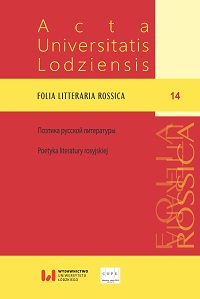Стихотворение Николая Гумилева «Неслышный, мелкий падал дождь…»: мотив двойничества и постижение природы зла
The Poem “Neslyshnyi, Melkyi Padal Dozhd’…” by Nikolai Gumilyov: The Motive of the Double and the Quest to Understand the Nature of Evil
Author(s): Arkadyi Aleksandrovich ChevtaevSubject(s): Literary Texts, Poetry, Studies of Literature, Russian Literature
Published by: Wydawnictwo Uniwersytetu Łódzkiego
Keywords: Nikolai Gumilyov; the double; dichotomy of good and evil; lyrical subject; lyrical narrative; symbolism
Summary/Abstract: The article discusses the poetics of a little-known poem, “Neslyshnyi, melkyi padal dozhd’…” [‘It was quiet and drizzling…’] (1907), in terms of the formation of the motif of the double as a key parameter of Nikolai Gumilyov’s artistic world. This text was not published during the poet’s lifetime and is known from an autograph in a letter to Valery Bryusov. Gumilyov’s refraining from publishing this poem could have had various causes, but the author of the paper attributes it to two factors. The first one is that it would have been difficult to embed this text in the conceptual logic of the cross-cutting “plots” of either Romanticheskiye tsvety [‘Romantic Flowers’] (1908) or Zhemchuga [‘Pearls’] (1910), i. e. poetic books the creation of which is chronologically close to the time of writing this poem. The second is the fact that “Neslyshnyi, melkyi padal dozhd’…” explicitly affirms the demonic principle in the human “self ” as an axiological constant, explicating the adherence to the “diabolical” poetics of early Russian symbolism, which Gumilyov had been trying to creatively rethink since 1907. However, despite the author’s neglect, the poem merits close attention, since it shows fundamentally important aspects of Gumilyov’s artistic conception. This poetic text is based on a narrative representation of the meeting between the lyrical subject and the character of a killer, who appears as his double, an alter ego of “the self ”. The analysis of the poem shows that recognizing the value of the painful existence of the demonic stranger is an act of comprehending the ontological nature of evil, which in the consciousness of the lyrical “I” acquires the status of something equivalent to the good of the existential constant. In the structure of this text the motif of the double, which goes back to the poetic practice of the romanticism and of the Russian symbolism, is realised on the story-plot level by dividing the human soul into two hypostases, the “light” and the “dark” one, the meeting of which becomes for the lyrical subject an initiation into the essence of another world. The author formulates the conclusion that getting to know the infernal side of the universe, here through the actualisation of the motif of the double, was in Gumilyov’s writing conceived as a necessary process of gaining spiritual experience that would synthesise the “light” (positive) and the “dark” (negative) aspects of being. Accordingly, the lyrical “I”’s encounter with his criminal- -demonic double presented in the discussed poem reveals the principles of formation of Gumilyov’s occasional mythopoetics based on the convergence of ontological antinomies.
Journal: Acta Universitatis Lodziensis. Folia Litteraria Rossica
- Issue Year: 2021
- Issue No: 14
- Page Range: 81-95
- Page Count: 15
- Language: Russian

